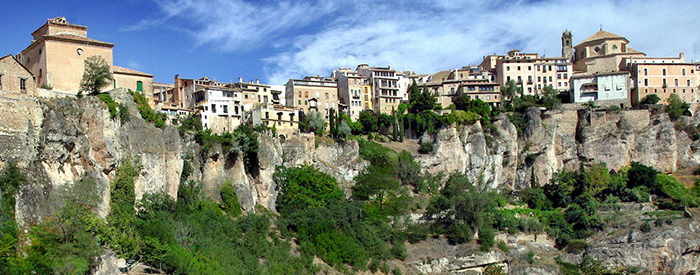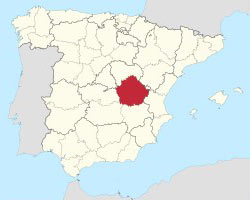Cuenca in Cuenca

The province of Cuenca is situated in the autonomous region of Castilla-La Mancha and shares borders with Teruel, Valencia, Albacete, Ciudad Real, Toledo, Madrid and Guadalajara. It covers a surface of 17,141 km2 which is 3.4% of the national territory, yet its population of 198,718 (2017) only constitutes 0.46% of the total Spanish population.
The highest point in the province of Cuenca is Pico del Mogorrita in the SerranIa de Cuenca. Its peak reaches 1864m above sea level.
Cuenca is a territory of water, being crisscrossed by rivers and dotted with freshwater lagoons. The countryside is stunning with lots of interesting limestone formations that have been eroded and shaped by wind and water of the millenniums. Notably La Ciudad Encantada (the Enchanted City) and El Ventano del Diablo (the Devil’s Window).
According to legend, the Devil’s Window was actually the devil’s skull and you look from the inside out through the eye sockets. The views from there were so stunning that people would swoon and fall to their death on the rocks 200m below.
Another wonder of nature well worth mentioning is the source of the river Cuervo which is a Monumento Nacional and a breathtaking sight all year round, not least in winter when it freezes over.
The capital of the province is also called Cuenca and it lies a little to the north of the centre of the province at a height of around 1,000m above sea level. It is home to around 54,876 people.
There is no evidence of any settlements on the actual site of Cuenca capital until the Moors established a fort and a city called Kinka. The year of its foundation is not clear but it is known that it existed by 784.
 After the reconquest the three main groups of the population, Muslims, Jews and Catholics, each had their own area of the city and lived in peaceful co-existence.
After the reconquest the three main groups of the population, Muslims, Jews and Catholics, each had their own area of the city and lived in peaceful co-existence.
Cuenca was granted city status by Alfonso X in 1257 and over the next three centuries the city’s economy started growing. The two big main areas of the economic growth were textile and livestock farming, and the cloth trade and the production of rugs brought along the need for wool processing. By the 16th century the population counted 15,000.
Sadly, the city experienced a gradual decline which lasted two hundred years and was caused by an outbreak of the plague followed by several bouts of drought and plagues of locusts, and the population was literally decimated and dropped down to 1,500 in the whole city.
But Cuenca recuperated and by 1900 the population was around 10,000 and since then the city has grown steadily.
Today, Cuenca’s main income comes from tourism due to its dramatic setting and amazing old town which is one of UNESCO’s World Heritage Sites. The city spreads out from atop a promontory overlooking the ruins of the Moorish castle, Künka, and below, the modem city grows on the Júcar plane.
Its main claim to fame are the Casas Colgadas (Hanging Houses) which are draped over the tall cliff overlooking the gorge deep down below. These houses with their typical wooden balconies are the symbol of the city although there are only three left. They were saved in the 1920s by the city architect.
The climate in Cuenca is warm in summer and cold in winter with frequent frosts and occasional snow.
Cuenca’s gastronomy is also worth mentioning. Many unique, local treats are available in the area: “Zarajos” (roast lamb tripe), “morteruelo” (a kind of pâté served hot) or ajoarriero (cod stew) to which can be added vegetable stews, roasts and river fish. Almonds, honey and figs are included in all kinds of imaginative cookery and make up the dessert known as “alajú” (a cake made of honey, figs and almonds).As for drinks, wines with the La Mancha Denomination of Origin and “resolI”, a liqueur made with coffee, sugar and orange peel, are outstanding.


